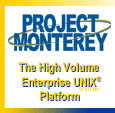
Building A UNIX Of The Future
SCO and IBM entered into a strategic business agreement
in October of `98 to aggressively accelerate growth of UNIX enterprise
servers. They are delivering a single UNIX product line for IA-32
systems and future IA-64 systems; the result, due in early Q2, 2000, is
a single product line on IA-32, IA-64 and IBM PowerPC, ranging from entry-level
servers to very large enterprise environments.
IBM is making SCO's UnixWare 7
IBM is making SCO's UnixWare 7 its 32-bit UNIX operating
system for the high-volume enterprise market, will promote and sell the
UnixWare 7 operating system worldwide and will offer it as a member of
its new UNIX product line. IBM is contributing AIX
technology to SCO's UnixWare to enhance scalability and enterprise
capabilities. IBM is allocating engineering resources to ensure the
availability of IBM and AIX middleware on the UnixWare platform.
SCO Monterey
Fact Sheet
IBM
Monterey Backgrounder
|
This industry standard Unix
operating system initiative for the IA-32, IA-64 and IBM Power PC processors
has a lot of weight behind it, and could prove to be Unix's revenge.
OEMs giving support are Acer, Bull, CETIA (a Thomson-CSF subsidiary), Compaq,
IBM Netfinity, ICL, Motorola, Samsung, Sequent, and Unisys. There is support
from 33 ISVs, including Baan, BEA, Computer Associates Compuware, DataPro,
Informix, Infospace, ompuware, DataPro,
Informix, Infospace, Micro Focus, Netscape, Novell, PeopleSoft, Pick, Progress,
Rational, Real World, Risk Management, Software AG, SAS, and Take Five.
Cygnus Solutions is developing, in conjunction with IBM, GNUPro tools for
AIX and Project Monterey on IA-64. SCO, as the volume market leader for
Unix with UnixWare7 is collaborating with IBM to enhance IA-32, and to
co-develop for the IA-64 market.
IA-64 Linux, Trillian, development
is being led by VA Linux Research with support from Cygnus, HP, IBM, Intel,
and SGI. Within the last month or so, both 64-bit W2K and Monterey/64 were
demonstrated on Merced without a software emulator, so they may well be
released around the same time. Sun has only got as far as demonstrating
Solaris with an emulator on the IA-64. Rajiv Samant, IBM's Unix brand general
manager claimed that Monterey/64 is ahead of HP-UX for the same reason,
although Intel says it is serious about its support of HP-UX.
IBM currently offers three
Unix systems, AIX, SCO, and Linux, and the company's vision is of a triangle
with Linux at the base, running on Netfinity servers and mostly used for
file and print, mail and collaboration. The second layer is AIX + RS/6000
(or UnixWare + Netfinity) being used typically for transactions such as
retail and branch banking.tail and branch banking.
The top layer is AIX + RS/6000
SP for ERP transactions and e-commerce. The boundaries between the three
layers are not intended to be solid, but in general, transaction value
is likely to increase up the triangle. IBM has recently clarified how it
will manage Sequent, a leader with high-end Intel-based Unix, which it
bought for $810 million. As the developer of DYNIX/ptx, its jewels are
the NUMA-Q 1000 and 2000 servers and the NUMACenter, which IBM and its
partners will start selling immediately.
On the development side,
NUMA technology should help IBM to offer larger SMP processors as synergies
are identified. NUMA works with Intel and Power chips. Before the merger,
IBM and Sequent were collaborating in Project Monterey, so both companies
are aligned. The NUMA-Q team will remain intact, but the Sequent name looks
like being subsumed in the IBM brand.
IBM plans that the Linux
application execution environment will provide most Linux APIs and ABIs
for AIX 4.3.3 + Monterey/64. Linux applications, which IBM says can be
readily recompiled for high performance on AIX/Monterey (or can run as
binaries without change) will go some way to providing an application portfolio
(for which read "overcome the applications barrier"). Thvercome the applications barrier"). The target date is
the first half of next year.
IBM will offer the Red Hat
Linux distribution for its ThinkPad 600E, and plans to offer the Caldera,
SuSe and TurboLinux on other ThinkPads. It also has a Developer Kit for
Linux in alpha, with Java 1.1.8 and a preview version of VisualAge Java
for Linux.
There seems to be quiet
confidence that only Monterey/64 will give high performance on Merced from
day one. However, it will effectively be a new operating system.
Linux is being positioned by IBM as a worthy junior partner in Monterey,
but not as a serious competitor in the same way as Win2k. For price-sensitive
organisations without too many high-value transactions, Linux will prove
attractive as it works well with less-expensive servers. Using Linux on
the desktop does not give such dramatic financial savings, and such users
are mostly the Microsoft-averse.
